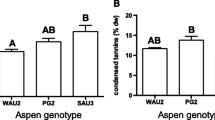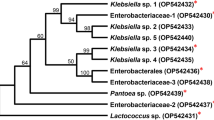Abstract
The submerged living larvae of Acentria ephemerella were fed in the laboratory with either M. spicatum or Potamogeton perfoliatus, two of their host plants. Larvae exhibited a reduced growth when fed M. spicatum, a freshwater angiosperm that contains high concentrations of tannins, secondary metabolites known for their herbivore-deterrent and antimicrobial properties. In this study, we investigated the influence of food-derived tannins on gut microbiota. Bacterial densities in the guts did not differ between the food regimes, ranging from 2.8 to 13.3 × 106cells per gut. Gut bacteria were characterized with cultivation techniques and subsequent identification of the strains by molecular methods. We isolated 17 bacterial strains belonging to all subdivisions, i.e., we identified α-, β- and γ-proteobacteria, Cytophyaga/Flavobacteria (CF) and several Gram-positive bacteria. All except one Gram-positive strain were found in the guts of larvae fed with P. perfoliatus. Gram-positive bacteria and bacteria of the CF cluster were more sensitive to polyphenol-containing extracts of M. spicatum in an agar diffusion assay than strains of the α- or γ-proteobacteria subdivision. Our results suggest an influence of food-derived tannins on gut microbiota in A. ephemerella.
Similar content being viewed by others
REFERENCES
Appel, H. M. 1993. Phenolics in ecological interactions: the importance of oxidation. J. Chem. Ecol. 19:1521–1552.
Appel, H. M. and Martin, M. M. 1990. Gut redox conditions in herbivorous lepidopteran larvae. J. Chem. Ecol. 16:3277–3290.
Appel, H. M. and Schultz, J. C. 1994. Oak tannins effectiveness of thuricide (Bacillus thuringiensis) in the gypsi moth (Lepidoptera. Lymantriidae). J. Econ. Entomol. 87:1736–1741.
Barbehenn, R. V. and Martin, M. M. 1992. The protective role of the peritrophic membrane in the tannin-tolerant larvae of Orgya leucostigma (Lepidoptera). J. Insect Physiol. 38:973–980.
Bernays, E. A. 1981. Plant tannins and insect herbivores: an appraisal. Ecol. Entomol. 6:353–360.
Cazemier, A. E., Hackstein, J. H. P., Op Den Camp, H. J. M., Rosenberg, J., and Van Der Drift, C. 1997. Bacteria in the intestinal tract of different species of arthropods. Microbiol. Ecol. 33:189–197.
Choi, C., Bareiss, C.,Walenciak, O., and Gross, E.M. 2002. Impact of polyphenols on the growth of the aquatic herbivore Acentria ephemerella (Lepidoptera: Pyralidae). J. Chem. Ecol. 28.
Clark, T. M. 1999. Evolution and adaptive significance of larval midgut alkalinization in the insect superorder Mecopterida. J. Chem. Ecol. 25:1945–1960.
Collins, V. G. and Willoughby L. G. 1962. The disruption of bacterial and fungal spores in Blelham Tarn with particular reference to an experimental overturn. Arch. Microbiol. 43:294–307.
Field, J. A. and Lettinga, G. 1992. Toxicity of tannic compounds to microorganisms, pp. 673–692 in R. W. Hemingway and P. E. Laks (eds.). Plant Polyphenols. Plenum Press, New York.
Gross, E. M. 2000. Seasonal and spatial dynamics of allelochemicals in the submersed macrophyte Myriophyllum spicatum L. Verh. Int. Verein. Limnol. 27:2116–2119.
Gross, E. M., Meyer, H., and Schilling, G. 1996. Release and ecological impact of algicidal hydrolyzable polyphenols in Myriophyllum spicatum. Phytochemistry 41:133–138.
Gross, E. M., Johnson, R. L., and Hairston N. G., JR. 2001. Experimental evidence for changes in submersed macrophyte species composition caused by the herbivore Acentria ephemerella (Lepidoptera). Oecologia 127:105–114.
Gross, E. M., Feldbaum, C., and Choi, C. 2002. High abundance of herbivorous Lepidoptera larvae (Acentria ephemerella Denis & Schifferm¨uller) on submersed macrophytes in Lake Constance (Germany). Arch. Hydrobiol. 155:1–21.
Henis, Y., Tagari, H., and Volcani, R. 1964. Effect of water extract of carob pods, tannic acid, and their derivates on the morphology and growth of microorganisms. Appl. Microbiol. 12:204–210.
Manuwoto, S. and Scriber, J.M. 1986. Effects of hydrolyzable and condensed tannin on growth and development of two species of polyphagous lepidoptera: Spodoptera eridania and Callosamia promethea. Oecologia 69:225–230.
Muyzer, G. T., Hottentraeger, S., Teske, A., and Wawer, C. 1996. Denaturing gradient gel electrophoresis of PCR-amplified 16S rDNA-a new molecular approach to analyse the genetic diversity of mixed microbial communities, pp. 3.4.4:1–23 in A. D. L. Akkermans, J. D. van Elsas and F. J. de Bruijn (eds.). Molecular Microbial Ecology Manual, 2nd ed. Kluwer Academic Publishers, Dordrecht, The Netherlands.
Muyzer, G. T., Brinkhoff, T., NÜubel, U., Santegoeds, C., SchÄfer, H., and Wawer, C. 1998. Denaturing gradient gel electrophoresis (DGGE) in microbial ecology, pp. 3.4.4:1–27 in A. D. L. Akkermans, J. D. van Elsas, and F. J. de Bruijn (eds.). Molecular Microbial Ecology Manuel, 3rd ed. Kluwer Academic Publishers, Dordrecht, The Netherlands.
Puupponen-Pimia, R., Nohynek, L., Meier, C., Kahkonen, M., Heinonen, M., Hopia, A., and Oksman-Caldentey, K.-M. 2001. Antimicrobial properties of phenolic compounds from berries. J. Appl. Microbiol. 90:494–507.
Russell, V. W. and Dunn, P. E. 1991. Lysozyme in the midgut of Manduca sexta during metamorphosis. Arch. Insect Biochem. Physiol. 17:67–80.
Scalbert, A. 1991. Antimicrobial properties of tannins. Phytochemistry 30:3875–3883.
Schultz, J. C., Hunter, M. D., and Appel, H. M. 1992. Antimicrobial activity of polyphenols mediates plant-herbivore interactions, pp. 621–692 in R. W. Hemingway and P. E. Laks (eds.). Plant Polyphenols. Plenum Press, New York.
Sher-Kaul, S., Oertli, B., Castella, E., and Lachavanne, J.-B. 1995. Relationship between biomass and surface area of six submerged aquatic plants species. Aquat. Bot. 51:147–154.
Spencer, C. M., Cai, Y., Martin, R., Gaffney, S. H., Goulding, P. N., Magnolato, D., Lilley, T. H., and Haslam, E. 1988. Polyphenol complexation-Some thoughts and observations. Phytochemistry 27:2397–2409.
Author information
Authors and Affiliations
Corresponding author
Rights and permissions
About this article
Cite this article
Walenciak, O., Zwisler, W. & Gross, E.M. Influence of Myriophyllum spicatum-Derived Tannins on Gut Microbiota of Its Herbivore Acentria ephemerella . J Chem Ecol 28, 2045–2056 (2002). https://doi.org/10.1023/A:1020754012785
Issue Date:
DOI: https://doi.org/10.1023/A:1020754012785




